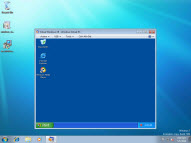Hands on: Windows 7 'XP Mode'

Over the past few days a huge number of electrons have been inconvenienced to bring you news about a new Windows 7 feature called XP Mode. In this post I'm going to take a closer look at this technology and what you need to make it work for you.
Check out the Windows 7 XP Mode gallery
[poll id="456"]

To get going with XP Mode you first need Windows 7. Specifically you need either Professional, Ultimate or Enterprise editions. Try setting up XP Mode on say Home Premium and it won't work.
You also need a CPU that supports chip-level virtualization, either Intel Virtualization Technology (Intel-VT) or AMD Virtualization (AMD-V). This presents a couple of problems. First, not all CPUs support chip-level virtualization (even some Core 2 Duo pieces don't). Secondly, this feature is disables by default by most BIOSes even when the CPU can handle it.
OK, so you install the XP Mode components. What next? Well, what you end up with is the XP SP3 OS running inside a window on your desktop. The default is that it XP Mode gets 256MB of RAM. If you want to give XP Mode more RAM, you can change this easily. As far as connecting to the network and Internet goes, this is handled using a shared networking NAT. Easy.
When you close the XP Mode Virtual PC window, this hibernates the XP OS. This is fine, but eventually you'll need to restart the OS. If you want to shut down the OS you'll have to do it manually. If you do, then restarting the virtual XP SP3 OS takes a little over a minute.
Applications you install into the XP Mode OS install shortcuts under the Windows Virtual PC entry on the Windows 7 desktop (as long as the shortcuts are put into the All Users Start Menu folder on the XP OS. If they're not, you'll have to move it manually. Pretty straightforward, if it works.
Next -->
The biggest problem I can see with XP Mode is that there isn't an awful lot of effort put into features to help you manage the OS. There's no feature to allow me to clone the OS, or to create snapshot or roll back the OS to an earlier state. I can manage XP Mode via the XP OS, but this feel kludgy to me. I'm not used to the feeling that I don't have a rollback feature to protect me from hosing the OS.
So, what's the bottom line here? Well, XP Mode is a nice addition to Windows 7, but only in so much as you get a free copy of XP SP3 and some degree of desktop/file system integration. If you can live with working with XP through XP Mode, and can live without protecting that virtual XP OS by using snapshots, roll backs and cloning, then XP Mode might be useful to you. However, if you're the kind of person already comfortable with running and maintaining PCs, XP mode will seem primitive at times.
So, those still reliant on XP have got some questions to face:
- "Will XP Mode work for me?"
- "How much hassle is managing multiple OSes?"
- "What are the hidden costs of running multiple OSes? Time? Money? learning curve?"
- "Am I better going for a commercial virtualization solution?"
- "Why not just stick with XP?"
Thoughts?
<< Home >>